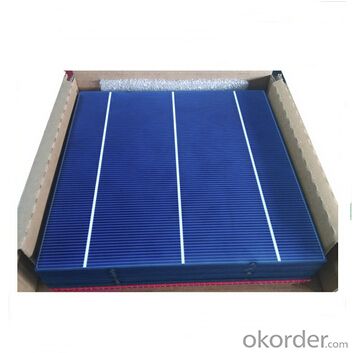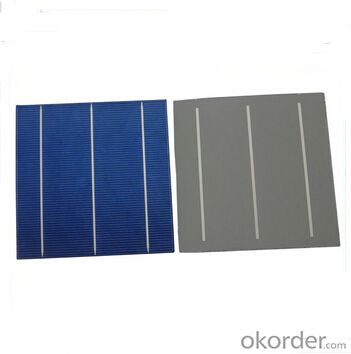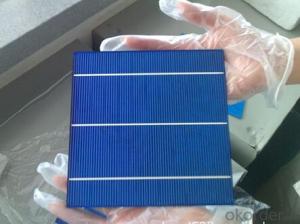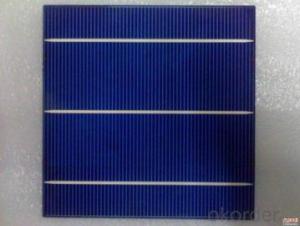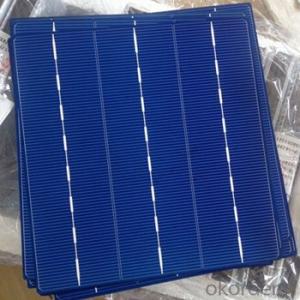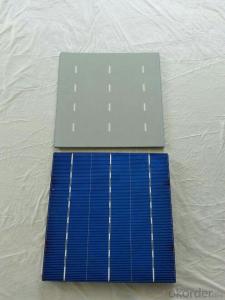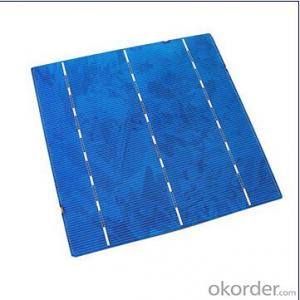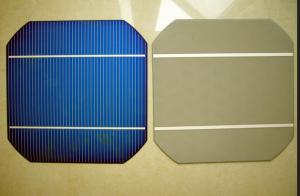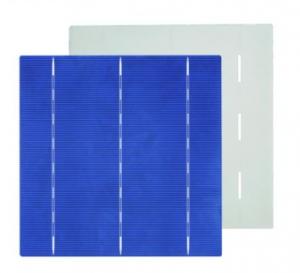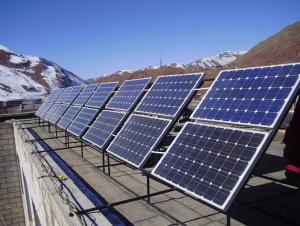2nd Generation Polycrystalline Silicon Solar Cell with 3 Bus Bars Alkaline
- Loading Port:
- Shanghai
- Payment Terms:
- TT OR LC
- Min Order Qty:
- 1000 pc
- Supply Capability:
- 1000000 pc/month
OKorder Service Pledge
OKorder Financial Service
You Might Also Like
PolyCrystalline Silicon Solar Cell 3 Bus Bars Alkaline:
Solar cells is made by solar wafer, it has three categories of solar cell right now, monocrystalline polycrystalline and thin film,These cells are entirely based around the concept PN junction, which is the critical part of solar module, it is the part that can convert the light energy into electricity, the thickness is from 180um to 200um, with even busbars to conduct electricity, textured cell can decrease diffuse reflection; they are often electrically connected and encapsulated as a module. Photovoltaic modules often have a sheet of glass on the front (sun up) side, allowing light to pass while protecting semiconductor wafers from abrasion and impact due to wind-driven debris, rain, hail, etc. Solar cells are also usually connected in series in modules, creating an additive voltage. Connecting cells in parallel will yield a higher current;With high quality and stable quality. Our Cells can greatly improve the performance of Solar Modules.
PolyCrystalline Silicon Solar Cell 3 Bus Bars Alkaline Advantage:
• High efficiency and stable performance in photovoltaic conversion.
• Advanced diffusion technique ensuring the homogeneity of energy conversion efficiency of the cell.
• Advanced PECVD film forming, providing a dark blue silicon nitride anti-reflection film of homogenous color and attractive appearance.
• High quality metal paste for back surface and electrode, ensuring good conductivity, high pulling strength and ease of soldering.
• High precision patterning using screen printing, ensuring accurate busbar location for ease with automatic soldering a laser cutting.
Specifications:
Efficiency code | 1640 | 1660 | 1680 | 1700 | 1720 |
Efficiency(min) (%) | 16.4 | 16.6 | 16.8 | 17.0 | 17.2 |
Pmax (W) | 3.991 | 4.040 | 4.088 | 4.137 | 4.186 |
Voc (V) | 0.621 | 0.622 | 0.623 | 0.625 | 0.627 |
Isc (A) | 8.203 | 8.267 | 8.335 | 8.398 | 8.454 |
Vmp (V) | 0.519 | 0.520 | 0.521 | 0.523 | 0.525 |
Imp (A) | 7.690 | 7.769 | 7.847 | 7.910 | 7.973 |
Packaging & Delivery of Polycrystalline Solar Cells
Carton Box Package and Deliver by air. It should be noticed that it should be avoid of water, sunshine and moist.

FAQ
We have organized several common questions for our clients,may help you sincerely:
①What price for each watt?
It depends on the efficiency of the solar cell, quantity, delivery date and payment terms.
②How long can we receive the product after purchase?
In the purchase of product within three working days, We will arrange the factory delivery as soon as possible. The pecific time of receiving is related to the state and position of customers.Commonly 7 to 10 working days can be served.
③Can you provide the peripheral products of the solar panels, such as the battery, controller, and inverter? If so, can you tell me how do they match each other?
Yes, we can, we have two companies for solar region, one is CNBM International, the other is CNBM engineering Co.
We can provide you not only the solar module but also the off grid solar system, we can also provide you service with on grid plant.
④What is your warranty of solar cell?
Our product can promise lower than 0.3% open box crack, we support claim after opening the box if it has crackm color difference or sth, the buyer should give pictures immediately, we can not accept the claim after the solar cell has assembled to solar panel.
• Timeliness of delivery
• ⑤How do you pack your products?
We have rich experience on how to pack the solar cell to make sure the safety on shipment, we could use wooden box or pallet as buyer's preference.
⑥ Can you do OEM for us?
Yes, we can.
- Q: What is the impact of solar cells on reducing energy waste?
- Solar cells have a significant impact on reducing energy waste as they harness clean and renewable energy from the sun, thus reducing the need for fossil fuels. By converting sunlight into electricity, solar cells provide a sustainable and environmentally friendly alternative, reducing greenhouse gas emissions and dependence on non-renewable energy sources. This helps combat climate change and promotes a more efficient use of energy, ultimately decreasing energy waste.
- Q: Can solar cells be used in remote locations?
- Yes, solar cells can be used in remote locations. Since solar cells generate electricity from sunlight, they do not require access to a power grid, making them an ideal solution for remote areas where traditional power sources may not be readily available. Additionally, advancements in solar technology have made it possible to store excess energy in batteries, ensuring a continuous power supply even during periods of low sunlight.
- Q: What is the cost of solar cells?
- The cost of solar cells can vary depending on various factors such as the type of solar cell, its efficiency, manufacturing process, and market conditions. Generally, the cost has been declining over the years and continues to do so. As of 2021, the average cost of solar cells is around $0.20 to $0.50 per watt. However, it's essential to consider the overall system cost, including installation, inverters, and other components, to determine the total investment required for a solar energy system.
- Q: Can solar cells be damaged by hail or other weather conditions?
- Yes, solar cells can be damaged by hail or other severe weather conditions. Hailstones or strong winds can cause physical damage to the surface of solar panels, leading to cracks or breakages. Additionally, extreme heat or cold can affect the efficiency and lifespan of solar cells. Therefore, it is important to consider the weather conditions and install appropriate protection measures to safeguard solar panels.
- Q: Are solar cells affected by electromagnetic radiation?
- Yes, solar cells are affected by electromagnetic radiation. Solar cells convert sunlight, which is a form of electromagnetic radiation, into electricity through the photovoltaic effect. However, it's important to note that certain types of electromagnetic radiation, such as infrared or ultraviolet radiation, can have varying effects on solar cell efficiency.
- Q: What is the effect of dust or dirt on solar cell performance?
- The effect of dust or dirt on solar cell performance is that it reduces the amount of sunlight reaching the solar cells, thereby decreasing their efficiency and overall power output.
- Q: Can solar cells be used for powering remote research stations?
- Yes, solar cells can be used for powering remote research stations. Solar cells, also known as photovoltaic cells, convert sunlight into electricity, making them an ideal and sustainable power source for remote locations. Solar panels can be installed at the research station to capture sunlight and generate electricity, which can then be stored in batteries for use during periods of low sunlight or at night. This enables the research station to operate independently of traditional power grids, reducing reliance on fossil fuels and providing a clean and renewable energy solution.
- Q: What are the safety considerations when installing solar cells?
- Some key safety considerations when installing solar cells include ensuring proper electrical grounding and wiring to prevent electrical hazards, following relevant building codes and regulations, using appropriate personal protective equipment (PPE) such as gloves and safety goggles, and taking precautions to avoid falls or injuries while working at heights. It is also important to carefully handle and dispose of any hazardous materials used in the installation process, such as chemicals or heavy metals found in certain types of solar panels.
- Q: Can solar cells be used in concert venues?
- Yes, solar cells can be used in concert venues. They can be installed on the rooftops or surrounding areas of the venue to convert sunlight into electricity. This renewable energy source can help power the venue's lighting, sound systems, and other electrical equipment, reducing dependence on traditional energy sources and lowering carbon emissions. Additionally, solar cells can be integrated into portable or temporary structures for outdoor concerts, providing clean energy during events.
- Q: Can solar cells be used for powering drones?
- Yes, solar cells can be used for powering drones. By converting sunlight into electricity, solar cells can provide a renewable source of power to drones, reducing the need for traditional batteries and increasing flight duration. Additionally, solar-powered drones have the potential to operate for extended periods without the need for frequent recharging, making them more sustainable and cost-effective in various applications.
Send your message to us
2nd Generation Polycrystalline Silicon Solar Cell with 3 Bus Bars Alkaline
- Loading Port:
- Shanghai
- Payment Terms:
- TT OR LC
- Min Order Qty:
- 1000 pc
- Supply Capability:
- 1000000 pc/month
OKorder Service Pledge
OKorder Financial Service
Similar products
Hot products
Hot Searches
Related keywords


